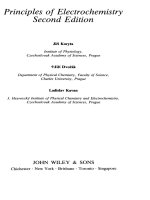Analycal Electrochemistry - Preface
Bạn đang xem bản rút gọn của tài liệu. Xem và tải ngay bản đầy đủ của tài liệu tại đây (117.75 KB, 6 trang )
xi
PREFACE
The goal of this textbook is to cover the full scope of modern electroanalyti-
cal techniques and devices. The main emphasis is on electroanalysis, rather
than physical electrochemistry. The objective is to provide a sound under-
standing of the fundamentals of electrode reactions and the principles of elec-
trochemical methods, and to demonstrate their potential for solving real-life
analytical problems. The high performance, small size, and low cost of elec-
trochemical devices has led to many important detection systems. Given the
impressive progress in electroanalytical chemistry and its growing impact on
analytical chemistry, this work offers also an up-to-date, easy-to-read presen-
tation of more recent advances, including new methodologies, sensors, detec-
tors, and microsystems. The book is suitable for a graduate-level course in
electroanalytical chemistry or as a supplement to a high-level undergraduate
course in instrumental analysis. It should also be very useful to those consid-
ering the use of electroanalysis in their laboratories.
The material is presented in six roughly equal chapters. The first chapter is
devoted to fundamental aspects of electrode reactions and the structure of the
interfacial region. Chapter 2 discusses the study of electrode reactions and
high-resolution surface characterization. Chapter 3 gives an overview of finite-
current-controlled potential techniques. Chapter 4 describes the electro-
chemical instrumentation and electrode materials (including new and modified
microelectrodes). Chapter 5 deals with the principles of potentiometric meas-
urements and various classes of ion-selective electrodes, while Chapter 6 is
devoted to the growing field of chemical sensors (including modern biosen-
sors, gas sensors, microchip devices, and sensor arrays). Numerous up-to-date
references, covering the latest literature, are given at the end of each chapter.
By discussing more recent advances, this book attempts to bridge the common
gap between research literature and standard textbooks.
This third edition of Analytical Electrochemistry is extensively revised and
updated, and reflects the rapid growth of electroanalytical chemistry since
1999. It contains a number of new topics, including DNA biosensors, imped-
ance spectroscopy, detection for capillary electrophoresis, diamond electrodes,
carbon-nanotube- and nanoparticle-based assays and devices, large-amplitude
AC voltammetry, microfluidic (“lab on a chip”) devices, or molecularly-
imprinted polymeric sensors. Other topics, such as the principles of potentio-
metric measurements, spectroelectrochemistry, electrochemiluminescence,
modified and microelectrodes, scanning electrochemical and atomic force
microscopies, electrical communication between redox enzymes and elec-
trodes, explosive detection, or enzyme and immunoelectrodes, have been
greatly expanded. The entire text has been updated to cover the very latest
(as of August 2005) developments in electroanalytical chemistry. Numerous
new illustrations, worked-out examples and end-of-chapter problems have
been added to this edition. Existing figures have been redrawn and improved.
In the 5 years since the second edition I have received numerous suggestions,
many of which have been incorporated in the second edition.
Finally, I wish to thank my wife, Ruth, and my daughter, Sharon, for their
love and patience; Vairavan Subramanian and Daphne Hui for their technical
assistance; the editorial and production staff of John Wiley & Sons, Inc. for
their help and support; Professor Erno Pretsch (ETH, Zurich) for extremely
useful suggestions; and the numerous electrochemists across the globe who led
to the advances reported in this textbook. Thank you all!
Joseph Wang
Tempe, AZ
xii
PREFACE
xiii
ABBREVIATIONS AND SYMBOLS
a Activity
A Area of electrode
Ab Antibody
AC Alternating current
AdSV Adsorptive stripping voltammetry
AE Auxiliary electrode
AES Auger electron spectroscopy
AFM Atomic force microscopy
Ag Antigen
ASV Anodic stripping voltammetry
B Adsorption coefficient
BDD Boron-doped diamond
C Concentration
C
dl
Differential capacitance
CE Counter electrode
CME Chemically modified electrode
CNT Carbon nanotube
CSV Cathodic stripping voltammetry
CV Cyclic voltammetry
CWE Coated-wire electrode
CZE Capillary-zone electrophoresis
D Diffusion coefficient
DME Dropping mercury electrode
DNA Deoxyribonucleic acid
DP Differential pulse
DPV Differential pulse voltammetry
E Potential (V)
∆E Pulse amplitude
E° Standard electrode potential
E
1/2
Half-wave potential
E
p
Peak potential
E
pzc
Potential of zero charge
EC Electrode process involving electrochemical followed by chemical
steps
ECL Electrochemiluminescence
EQCM Electrochemical quartz crystal microbalance
ESCA Electron spectroscopy for chemical analysis
EXAFS X-ray adsorption fine structure
F Faraday constant
FET Field effect transistor
FIA Flow injection analysis
f
i
Activity coefficient
f
0
Base resonant frequency
FTIR Fourier transform infrared
∆G‡ Free energy of activation
HMDE Hanging mercury drop electrode
i Electric current
i
c
Charging current
i
t
Tunneling current
IHP Inner Helmholz plane
IRS Internal reflectance spectroscopy
ISE Ion-selective electrode
ISFET Ion-selective field effect transistor
J Flux
k
ij
pot
Potentiometric selectivity coefficient
k° Standard rate constant
K
m
(1) Michaelis Menten constant; (2) mass transport coefficient
LB Langmuir–Blodgett
LCEC Liquid chromatography/electrochemistry
LEED Low-energy electron diffraction
m Mercury flow rate (in polarography)
∆m Mass charge (in EQCM)
MFE Mercury film electrode
µTAS Micro–total analytical system
MIP Molecularly imprinted polymer
MLR Multiple linear regression
MWCNT Multiwall carbon nanotube
N Collection efficiency
n Number of electrons transferred
NP Normal pulse
xiv
ABBREVIATIONS AND SYMBOLS
O The oxidized species
OHP Outer Helmholz plane
OTE Optically transparent electrode
PAD Pulsed amperometric detection
PCR Principal-component regression
PLS Partial least squares
PSA Potentiometric stripping analysis
PVC Poly(vinyl chloride)
q Charge
QCM Quartz crystal microbalance
R (1) Resistance; (2) gas constant
R
p
Electron transfer resistance
R
s
Ohmic resistance of the electrolyte solution
RDE Rotating disk electrode
Re Reynolds number
RE Reference electrode
RRDE Rotating ring–disk electrode
RVC Reticulated vitreous carbon
S (1) Barrier width (in STM); (2) substrate
SAM Self-assembled monolayer
SECM Scanning electrochemical microscopy
SEM Scanning electron microscopy
SERS Surface enhanced Raman scattering
SPM Scanning probe microscopy
STM Scanning tunneling microscopy
SW Square wave
SWCNT Single-wall carbon nanotube
SWV Square-wave voltammetry
T Temperature
t Time
t
m
Transition time (in PSA)
U Flow rate
UHV Ultrahigh vacuum
v Potential scan rate
V
Hg
Volume of mercury electrode
W Peak width (at half-height)
WE Working electrode
WJD Wall-jet detector
XPS X-ray photoelectron spectroscopy
α Transfer coefficient
Γ Surface coverage
γ Surface tension
δ Thickness of the diffusion layer
δ
H
Thickness of the hydrodynamic boundary layer
ABBREVIATIONS AND SYMBOLS
xv









